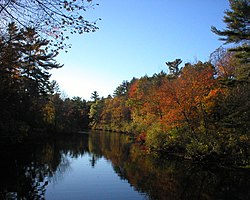Ipswich River
| Ipswich River | |
|---|---|

|
|
| Country | United States |
| Basin features | |
| Main source |
Burlington, Massachusetts 42°33′14″N 71°08′38″W / 42.5539828°N 71.1439441°W |
| River mouth | Ipswich Bay, Massachusetts 42°41′38″N 70°47′23″W / 42.6939825°N 70.7897712°WCoordinates: 42°41′38″N 70°47′23″W / 42.6939825°N 70.7897712°W |
| Basin size | 155 sq mi (400 km2) |
| Tributaries |
|
| Physical characteristics | |
| Length | 35 mi (56 km) |
Ipswich River is a small river in northeastern Massachusetts, United States, mighty in importance in early colonial migrations inland from the ocean port of Ipswich which could provide safe harborage in offshore Plum Island Sound to early Massachusetts subsistence farmers who doubled often as fishermen. A part of the river forms town boundaries and divides Essex County, Massachusetts on the coast from the more inland Middlesex County. It is 35 miles (56 km) long, and its watershed is approximately 155 square miles (401 km2), with an estimated population in the area of 160,000 people.
Historically, the settlement of Essex County began at the oldest community there, the tiny seaport of Agawam (later renamed Ipswich), and typically proceeded westward and northward along the Ipswich or its tributary creeks. When Middlesex County was formed in the Massachusetts Bay Colony, only Salem and Charlestown across the Charles River mouth and Boston harbor's inner estuary from Boston's much smaller hill dominated peninsula were older settlements.
The upper river runs through and drains at least parts of Burlington, The lower river forms part of the borders between the Towns:
The wide swamps along the river made it impossible to ford the stream anywhere east of Wilmington in colonial times. The only route north out of Boston to the northeast (Today called the Northshore) was via the Andover Road, an often muddy track, later made a wagon road which forded the stream just below the confluence of Lubbers and Maple Meadow brooks.
The topography of eastern Massachusetts was determined most by the fact that, at the maximum glaciation of the Era, it was the site of the edge of the last glaciation, at approximately 18,000 BC. This glacier had planed the land under it nearly flat. Gravel- and boulder-lined streams ran along its surface. From 18,000 to about 10,000 BC, the glacier receded, dropping its stony contents as eskers and moraines, the dominant features of the region. The glacier's recession created ridges, deposited sand and gravel, the dominant material of the riverbed, over which mud has been deposited. Low-gradient drainage created the meandering streams, which typically drop no more than 30–40 feet.
...
Wikipedia
